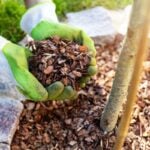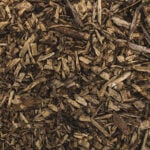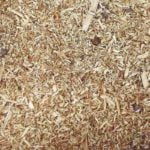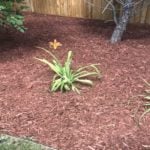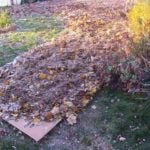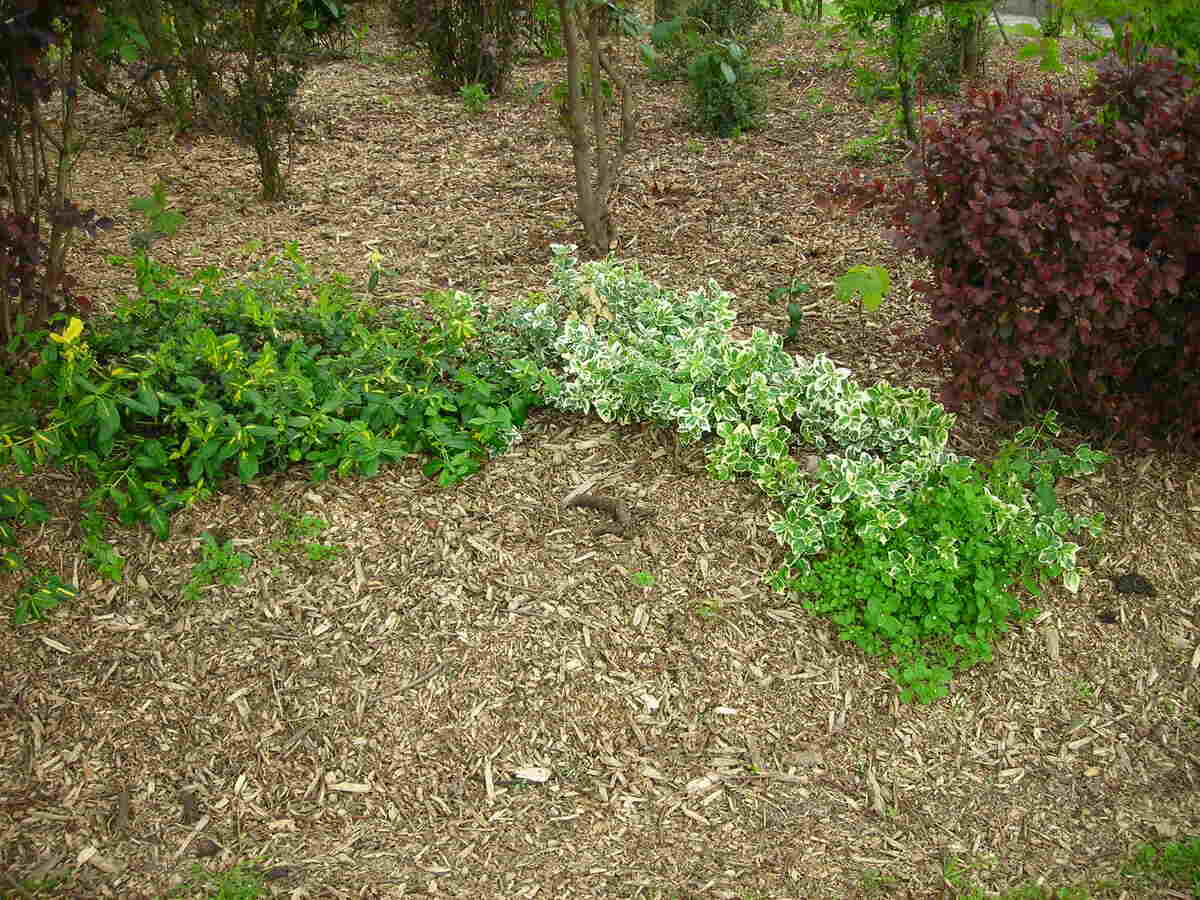
As a protective material gardeners spread on the soil, mulch ensures healthier plants, water savings, fewer weeds, and other great benefits, but only when used in the right amounts.
If the mulch is too thick, your plants might rot and wilt. Too thin, and weeds will push through. While a mulch layer of 2 to 3 inches is safe and useful for most plants, optimal results come from knowing how deep the mulch should be in every garden scenario — from protecting delicate crops to nurturing mighty trees.
The Ideal Mulch Depth
| Quick Answers for Busy Gardeners | |
| Trees and Shrubs: 2 to 4 inches Flower Beds and General Landscaping: 2 to 3 inches Vegetable Gardens: 1 to 2 inches Lawns: Up to 1 inch | Fine Mulches: Up to 2 inches Coarse Mulches: Up to 3-4 inches |
Note: If you are unsure what type or depth of mulch is best for your plants, ask a landscaping professional.
Trees and Shrubs (2 to 4 Inches)
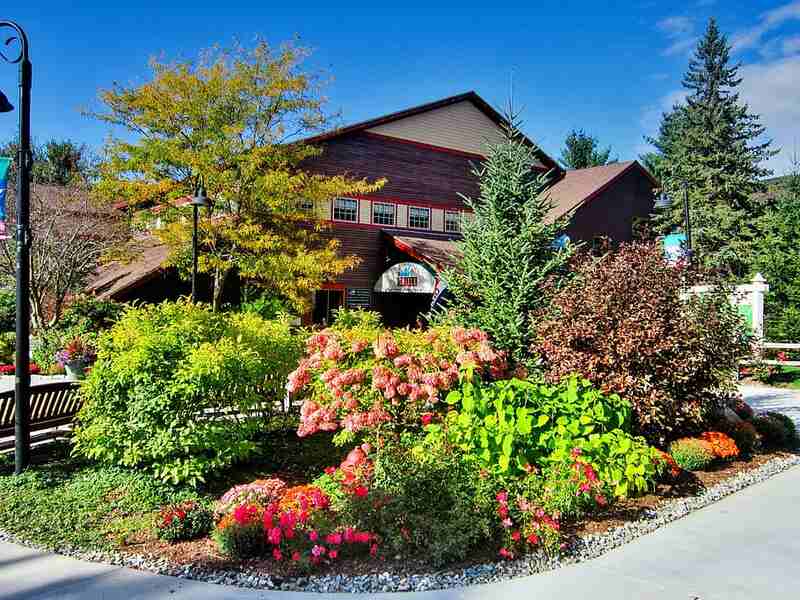
Larger in size and with a longer lifespan, most woody perennials thrive with deeper mulch that provides better moisture retention and year-round insulation.
A 3-inch layer is a good place to start as it provides the “main benefits of mulching,” says Bert Cregg, professor of horticulture and forestry at Michigan State University in East Lansing.
“My approach is to start new beds with about 3 inches of mulch and then apply a light top-dressing each spring to freshen up the look,” Cregg adds.
Best mulch for trees and shrubs: Wood chips and ground bark.
Installation Tip: Leave a 2- to 6-inch mulch-free area around the tree trunk and spread the mulch up to the outer edge of the canopy (also called the dripline). Avoid covering the tree root flare (the tree’s base where the trunk widens and transitions into roots) with mulch.
See Related:
Flower Beds and General Landscaping (2 to 3 Inches)
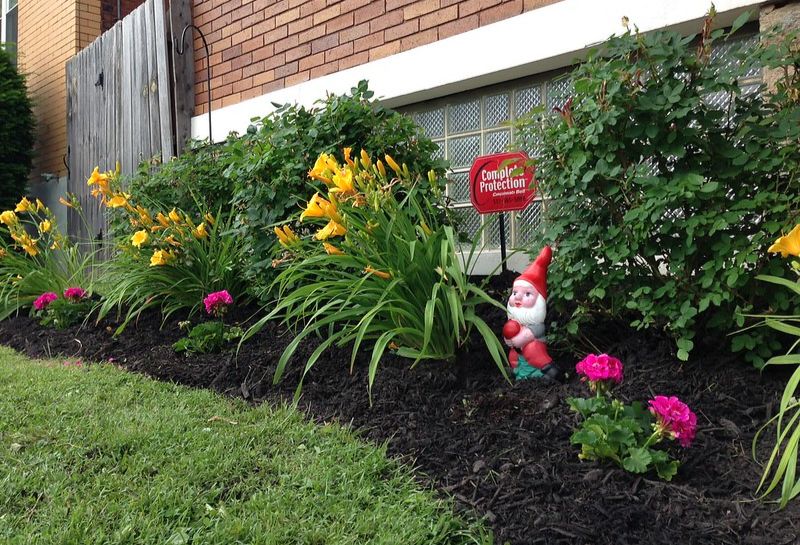
Roses, azaleas, camellias, and most flowering plants do well with moderately deep mulch that insulates and prevents weeds without smothering the delicate plant stems.
Best flower bed mulch: Pine bark mini-nuggets, pine straw, hardwood chips, and cypress shavings.
Installation Tip: Leave about 1 inch of space around plant stems and extend the mulch beyond the plant’s canopy.
See Related: How To Remove Leaves From Mulch and Flower Beds
Vegetable Gardens (1 to 2 Inches)
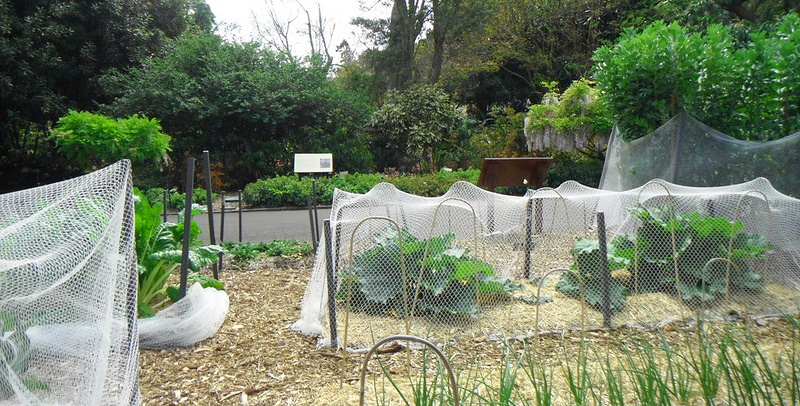
Rely on 1 to 2 inches of mulch to nurture your veggies to healthy maturity and bountiful crops. The thinner layer retains moisture while allowing sunlight to warm the soil and support plant growth.
Best mulch for garden beds: Straw, shredded leaves, and dry grass clippings.
Installation Tip: Apply a thicker layer (3 to 4 inches) if you have a severe weed problem or it’s a dry summer, but check the soil moisture regularly.
Lawns (1/2 to 1 Inch)
A thin layer of mulch can improve grass and soil health and reduce fertilization and irrigation needs. Thick mulch (over 1 inch) can create a “thatch” effect, blocking sunlight and airflow and limiting water absorption, but this rarely happens.
Unless thick thatch (over 1/2 inch) or a low microbial population slows decomposition, mulched grass clippings rarely build up to more than 1 inch thick.
Pro Tip: Mulch fallen leaves into your lawn only when they cover less than 50% of the turf surface; otherwise, rake and bag. Compost is denser — apply only a 1/4 to 1/2 inch topdressing layer.
Best mulch for lawns: Grass clippings, compost, or shredded leaves
See Related:
Mulch Depth by Mulch Materials
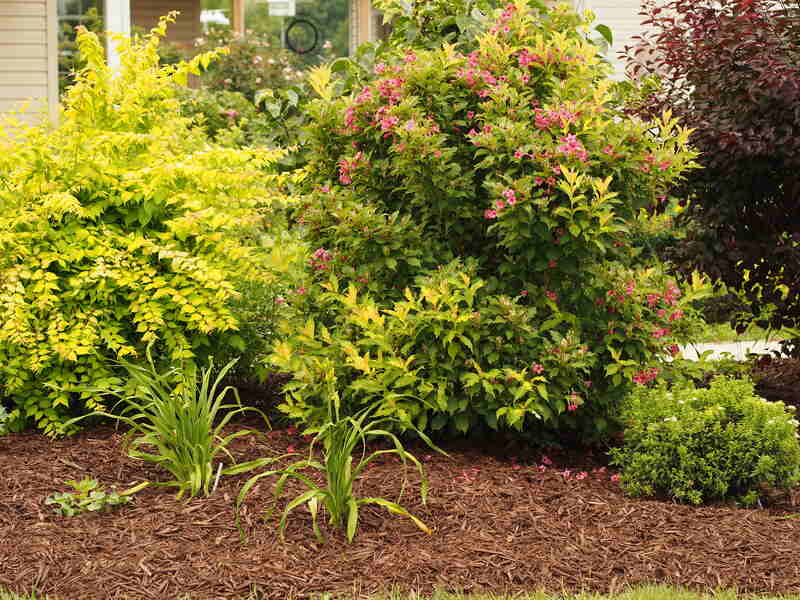
How many inches of mulch do you need? Fine mulch, like sawdust, has tiny particles that can knit together into a crust that repels water and limits airflow. Apply it in moderately thick layers up to 2 inches deep.
Wood chips and other coarse-textured mulch allow better airflow and water penetration and can be applied up to 3-4 inches thick.
The table below shows the recommended mulch depth for common types of mulch.
| Mulch Type | Best Mulch Depth | How Often to Replace/Topdress |
| Cocoa Bean Hulls | 3-4 inches | Annually |
| Compost or Leaf Mold | 1-3 inches | Twice a year |
| Grass Clippings | Up to 3 inches (dry) Up to 1 inch (fresh) | Every 2 to 3 weeks or every time you mow the lawn |
| Gravel, Pebble Stone | 1 inch | Refresh once every 3 to 5 years for a fresh appearance |
| Landscape fabric | 1 layer | Annually |
| Leaves | 2 to 3 inches (shredded) 6 inches (whole) | Annually |
| Pecan Nut Shells | 1-2 inches | Every 1 or 2 years |
| Pine Needles | 3 to 4 inches or more | Annually |
| Rubber Mulch | 1-2 inches (plants) 4-6 inches (playgrounds) | 10 to 12 years |
| Tree Bark | 3 to 4 inches | Every 1 to 2 years |
| Sawdust | 1 to 2 inches | Annually |
| Straw, Hay | 6-8 inches | Annually |
| Wood Chips | 2 to 4 inches | Annually |
The depth also depends on how often you plan to refresh the mulch. As long as it benefits the plant, you can use a thicker layer to reduce the frequency of application.
“Applying deeper mulch is more costly and more work on the front-end, but you can go longer between top-dressings.” says Cregg.
Pro Tip: Inorganic mulch, like gravel, doesn’t release nutrients and can heat up during the summer, so use it sparingly around your plants.
See Related: Mulch Guide: Types, Pro Tips and Where to Mulch
When to Apply Less Mulch (up to 2 Inches)
Use thinner layers when the top benefits of mulch, such as moisture retention and temperature moderation, can backfire and damage the plants.
| When to Apply Less Mulch | Mulch Depth | Why a Thinner Mulch Layer? |
| Around Perennials (Spring) | 1-2 inches | It allows the sunlight to warm up the spring soil and wake up dormant plants. |
| Small Plants | 1-2 inches | It doesn’t cover or smother small plants. |
| Poorly Drained Soils | Under 2 inches | Speeds evaporation from waterlogged soils while preventing clay soils from crusting. |
| Already Mulched Areas | About 1 inch | It supplements the existing mulch without creating an overly thick layer. |
| On Slopes | 1-2 inches | Less likely to slide during heavy rain and cover plants downhill. |
Anchor mulch with pegs and twine or netting on slopes steeper than 3:1 (18 degrees). Don’t use organic mulch on slopes steeper than 1.5:1 (33 degrees).
For mulching slopes, Cregg recommends coarse mulch such as arborists’ wood chips or coarse ground bark. They have “a better chance to stay in place because the pieces can interlock and are less likely to move,” says Cregg.
When to Apply Deeper Mulch (up to 6 Inches)
Apply a thicker layer of mulch when your plants and soil need more water, organic matter, and insulation.
| Where to Use Thicker Mulch | Mulch Depth | Why a Thicker Mulch Layer? |
| Newly Landscaped Areas | 3-4 inches | Helps plants establish roots more easily by ensuring constant moisture and a moderate soil temperature. |
| Winter Protection in Cold Climates | 4-6 inches | Keeps perennial plants’ crowns and roots warm and safe from freezing during winter. |
| Sandy Soils | 3 inches | Improves sandy soil’s texture and water retention ability. |
Common Mulching Mistakes to Avoid
Overall, mulching is an effective and straightforward garden hack, but it can cause trouble if used incorrectly. Here are the most common mulching mistakes to avoid for a thriving garden.
- Volcano mulching: Piling mulch against tree trunks (“volcano” mulching) traps moisture and creates perfect conditions for fungi, pests, and bark decay.
- Excessive mulch depth: Smothering the soil with a thick mulch blocks air and water flow, exposing plants to suffocation and dryness. On wet soils, overmulching inhibits excess water from evaporating and leads to root rot.
- Annual over-application: Applying mulch to a garden bed too often can lead to overly thick layers. Only topdress mulch when at least 1/2 inch is lost; don’t exceed the recommended depth.
- Wrong material: Unsuitable mulch can infest your yard with weeds (e.g., grass clippings with weed seeds) or harm soil pH (pine needles around plants that don’t love acidic soil).
- Herbicide carryover: Using grass clippings, straw, or hay treated with herbicides can contaminate your garden beds with chemicals. Only use mulch from trusted sources, especially if you grow organic vegetables.
Pro Tip: Rake the old layer to improve air flow. Remove the old mulch layer once every 3 to 5 years or if you have fungal or pest problems.
See Related: How Often Should You Replace Mulch?
FAQ
The best mulch depth to prevent weed growth without suffocating plants is generally 3 to 4 inches. For straw, which is very fluffy and compacts easily, apply 4 to 6 inches (go up to 8 if the area is unplanted or mulched rarely).
The benefits of proper mulching are:
• Weed control
• Water conservation
• Erosion prevention
• Less to no tilling
• Healthier plants, more resilient to drought and heat
• Better crops
• Improved curb appeal
To determine how much mulch you need at the proper depth, use an online mulch calculator or do the following:
• Measure the area you need to cover.
• Multiply the square footage by the mulch depth in inches and divide by 12.
• The value is the cubic feet of mulch you need.
• Divide the value in cubic feet by 27 to find out how many cubic yards of bulk mulch to buy or by 2 to learn the equivalent in 2 cubic feet mulch bags.
Expert Mulching, Zero Effort
Why struggle with technical details and heavy bags? LawnStarter connects you with skilled landscapers who can deliver and install the perfect mulch layer on your yard.
Sources:
- “A Bay-Friendly Landscaping Guide To Mulch.” Bay Friendly Landscaping Program. City of Cotati.
- Bert Cregg, professor of horticulture and forestry at Michigan State University in East Lansing. Personal interview.
- “Care of Ornamental Plants in the Landscape.” University of Georgia Extension.
- “Guide to Mulches.” Washington State University.
- “Mulches for the Landscape.” University of Mississippi.
- “Mulching Landscape Beds FAQs.” By Bert Cregg, professor of horticulture at Michigan State University.
- “Water Footprint and Water Productivity Analysis of an Alternative Organic Mulching Technology for Irrigated Agriculture.” By Tommaso Pacetti et al. Published in Agricultural Water Management.
Main Image Credit: Jmalo / Wikimedia Commons / CC BY-SA 4.0

